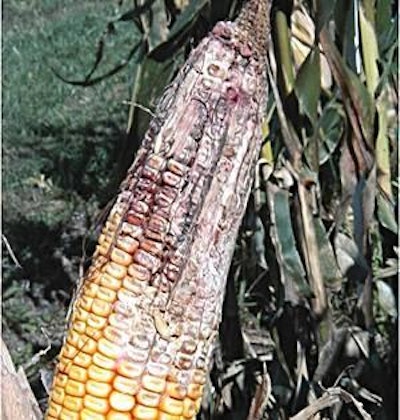
Masked mycotoxins—non-extractable forms of vomitoxin, zearalenone, T-2 toxin and DAS conjugated with glucose, sugar or fatty acids—have long proven difficult to detect, a factor contributing to inaccurate estimates of mycotoxin levels in animal feed, with risks to animal health, production and performance.
Contamination can mean reduced production efficiency and serious economic losses to dairy producers. For example, Deoxynivalenol, also known as DON or vomitoxin, is a common type B trichothecene mycotoxin that can be found masked. Produced by many Fusarium species, it is found as a contaminant of crops worldwide.
Potential for improved analysis
But now researchers have identified what may lead to a better understanding of optimum conditions for detecting these elusive metabolites.
Trevor Smith, professor with the Department of Animal and Poultry Science, University of Guelph, Ontario, Canada, along with post-doctoral researcher Si-Trung Tran, have discovered environmental factors that may contribute to improved analysis of mycotoxins, specifically those that are considered masked and difficult to detect.
Past research has shown common methods for DON analysis in feedstuffs are unable to effectively detect conjugated, or masked, mycotoxins. In their study, Smith and Tran sought to determine optimal conditions in which non-extractable—or conjugated—DON in corn and wheat can be hydrolyzed by trifluoromethanesulfonic acid (TFMSA). TFMSA is known to remove the sugar entity from glycoproteins regardless of linkage and composition.
DON is seen most often in feeds when rainy, warm weather extends from the time of flowering to harvest, which promotes infection in corn and small grains. Low temperatures following infection of grains may further increase production of the mycotoxins. Many experts consider DON to be a “marker” for other problems in feed. If it is present, conditions have been right at some stage for mold growth and production of other toxins.
In the study conducted by Smith and Tran, 10 naturally contaminated corn samples as well as 10 naturally contaminated wheat samples were collected from the 2006 and 2008 crops in Ontario, Canada. In reviewing the given reaction factors in the hydrolysis of conjugated-DON by TFMSA, reaction temperature was identified as the most significant in both corn and wheat.
Total DON concentrations were determined using ELISA kits. The optimal hydrolysis conditions for determination of conjugated DON in corn and wheat were determined. Using these optimal hydrolysis conditions, the six naturally contaminated corn samples and five naturally contaminated wheat samples were analyzed to determine the presence of conjugated DON. All samples contained conjugated DON in significant amounts with an increase of 17 to 69 % of DON in corn following hydrolysis and an increase of 21 to 72 % of DON in wheat following hydrolysis.
The researchers were able to conclude that the optimal conditions for TFMSA hydrolysis of conjugated DON in corn and wheat could be identified and that this would be useful in accurately determining total DON content of grains and detection of conjugated DON in feeds and foodstuffs. The researchers found that at a given reaction temperature, the recovery of DON varied with reaction duration and acid concentration. The study is thought to have resulted in the first report of the effect of acid concentration on hydrolysis efficiency in the determination of DON recovery in grain samples.
Under optimal conditions for hydrolysis, the researchers found that the masked mycotoxin DON was detected along with free DON in all naturally contaminated corn and wheat samples at a rate of up to 70 % for corn samples and up to 75 % for wheat. They note that the significant increases in total DON were not highest in either the most highly contaminated corn samples or the most highly contaminated wheat samples.
“It is possible that the presence of conjugated-DON might be strongly influenced by the metabolic capacity of the host plant in conjunction with other factors, such as microclimates, plant disease or insect injury. All can provide the host plant with favorable conditions for metabolism of DON,” they sum up.
The study underscored that significant amounts of non-detectable conjugated-DON can be found in Canadian wheat and corn samples.
Complex problem
Accurately detecting and analyzing mycotoxin content in animal feed is a complex problem, agrees Dr. Alexandros Yiannikouris, Alltech’s coordinator of glycomics research. If mycotoxin detection were an easy task, he adds, then the industry would probably not see such a wide array of often-complex approaches employed to analyze their occurrence.
Noting that there are a number of pitfalls in the use and application of methods for measuring mycotoxins in feed, he adds, “Mycotoxins can be found as conjugated metabolites to one or several glycosides or glucuronides residues, masking the mycotoxin from being detected…even using an analytical procedure.” He continues that constant improvement in analytical devices and procedures can help reduce future inaccuracies in estimating mycotoxin levels.
“The main challenge in developing analytical procedures is the diversity of the mycotoxin molecules—around 500 currently identified—with each one exhibiting different toxicity and economic impacts,” he says. “In addition, mycotoxin contamination depends on environmental conditions that favor the growth of mold and trigger mycotoxin synthesis.”
But difficulties in detecting mycotoxins are only part of the picture. A mycotoxin strategy plan must also protect cattle from toxic effects once contamination has been determined or suspected.
Because hidden mycotoxins are expected to remain difficult to detect—despite recent efforts—the potential toxicity remains a threat, as further evidenced by mycotoxin outbreaks at what has been thought to be rather low or even undetectable levels of mycotoxins.
If strategies aren’t implemented to control impacts of mycotoxins, herds will have to weather the economic losses which can come about even when mycotoxin analysis is followed under optimal conditions.
Dr. Elizabeth Santin, Department of Veterinary Medicine, Federal University of Parana, Brazil, is well-known for her work in the area of mycotoxins and recommends the use of a quality mycotoxin adsorbent or binder to minimize economic loss.
She adds: “When selecting a mycotoxin binder it is important to consider the published data demonstrating its efficacy within the target animal species.”
.jpg?auto=format%2Ccompress&crop=faces&fit=crop&h=48&q=70&w=48)


.jpg?auto=format%2Ccompress&fit=crop&h=167&q=70&w=250)
.jpg?auto=format%2Ccompress&fit=crop&h=167&q=70&w=250)











